Using Electric Drives for Active Noise Generation
- PDF / 474,710 Bytes
- 4 Pages / 595.276 x 790.866 pts Page_size
- 17 Downloads / 423 Views
AUTHORS
Prof. Dr.-Ing. Stefan Sentpali is Professor of Acoustics and Automotive Engineering at the Munich University of Applied Sciences and Co-Founder and Member of the Supervisory Board of the Research Institute MdynamiX AG in Munich (Germany).
Using Electric Drives for Active Noise Generation MdynamiX, the Affiliated Institute of the Munich University of Applied Sciences, is researching noise generation using electric drives in order apply this approach to acoustic function augmentation in the future. The electric motor virtually becomes a loudspeaker and can thus serve as a so-called Acoustic Vehicle Alerting System (AVAS). Without additional hardware, the applications developed can be used not only to realize the required warning signals for electric vehicles, but also to design brand-specific sounds. The basic functionality of electric drives is not affected or even disturbed.
Fabian Ebner, M. Sc. is Acoustic Engineer at MdynamiX AG in Munich, the Affiliated Institute of the University of Applied Sciences Munich (Germany).
Dominik Schubert, M. Sc. is Research Assistant at the Department of Mechanical and Automotive Engineering at the Munich University of Applied Sciences and Control Engineer at MdynamiX AG, the Affiliated Institute of the Munich University of Applied Sciences (Germany).
Leonhard Angerpointner, M. Sc. is Control Engineer at M dynamiX AG in Munich, the Affiliated Institute of the Munich University of Applied Sciences (Germany).
© Dean Clausevic
70
asynchronous machines and DC machines. The direct stimulation of these motor control components in radial and tangential direction (flux-forming and torque-forming current components) enables the excitation of radial and tangential internal forces, which in turn can be directly converted into perceptible vibrations or structure-borne sound by the mechanical impedances of stator and rotor. Depending on the application and the acoustic transmittance of the motor’s connecting structures, the generated vibrations and airborne sound are radiated, FIGURE 1. A special feedforward control of the set point variables before and after the motor current controller enables the desired sound generation with electric drives. This approach allows independence from the motor current controller topology and avoids having to disclose the OEM or subsystem manufacturer’s control technology that is worthy of protection. The patent of MdynamiX and the Munich University of Applied Sciences [2] describes the concept in more detail.
1 INTRODUCTION 2 FUNCTIONING OF THE PRO CESS 3 APPLICATION E X AMPLES 4 ANALY TICAL DESIGN TO OL 5 APPLICATION FOR E X TERNAL NOISE GENER ATION 6 USE ON SERIES HARDWARE 7 P OTENTIAL FOR ACTIVE NOISE CANCELL ATION 8 SUMMARY
3 APPLICATION EX AMPLES
1 INTRODUCTION
With electric drives, noises and sounds can be actively generated. For this so-called Active Sound Generation (ASG), there are first fields of application for developers of vehicles and vehicle systems, especially electric drives and components, following five years of research.
Data Loading...










